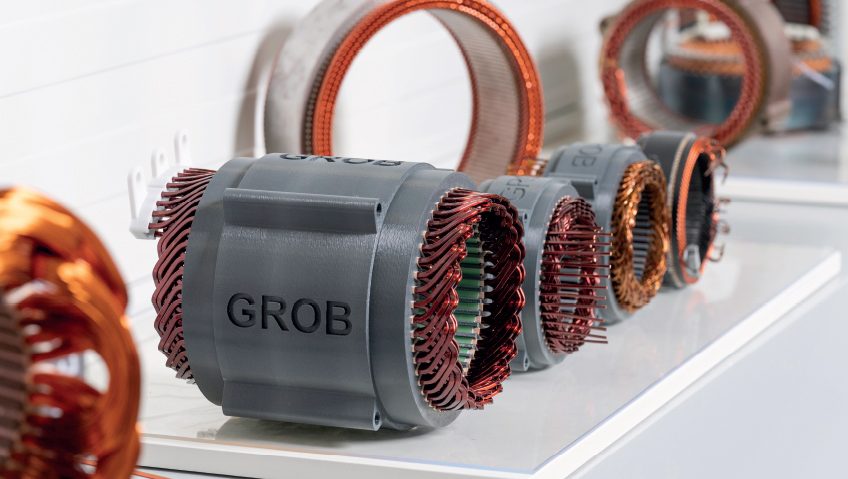GROB Systems, Inc. (pronounced ‘Grow-buh’) is in the midst of a massive expansion. The manufacturing equipment provider, specializing in machining centers, industrial software, automated pallet systems, and other solutions, is headquartered in Mindelheim, Germany with a site in Bluffton, Ohio. The Bluffton branch is growing rapidly to fulfill demand from clients in the e-mobility sector.
“We are adding another 135,000 square feet of new production area, and we have the option to add another four construction stages of similar size, which provides us the flexibility to expand our company further as business keeps growing over the next years,” states Chief Sales Officer Thomas Neubert. “These expansions are being driven by the need for more space for projects in the EV (electric vehicle) industry.”
Once the expansion is complete, the Bluffton facility will top half a million square feet. The Ohio plant is GROB’s only North American production plant, although the company also has production plants in Germany, Italy, India, China, and Brazil, and service and sales offices in 15 additional countries in the world.
Since last year, GROB has launched new solutions and maintained a hiring spree. “As of today, we’re at 839 employees [in Bluffton], plus around a ballpark of 50 contractors. So there are about 900 people here. At the end of 2025, we project around 1,100,” says Apprenticeship Training Supervisor Mark Reed.
Founded by Dr. Ernst Grob in Munich in 1926, the company was initially known as a manufacturer of machining centers. Over the decades, it expanded its product line and global presence. The Bluffton branch was founded in 1983.
While serving a variety of sectors including aerospace, defense, energy, medical, and die and mold, automotive now accounts for roughly 80 percent of the company’s workload, says Neubert. Half of all automotive work involves EVs. GROB designs and builds systems for producing rotors, stators, electric drive units, battery cells, modules, and packs for the e-mobility market.
In order to optimize weight, several OEMs shifted from using several smaller sheet metal parts to produce certain parts of the chassis to so called “mega-castings,” gigantic aluminum die cast parts, that make up half of the vehicle’s structure. Such structures are also used for battery housings in EVs. Given these realities, GROB recently expanded its F-Series with the larger G900F and G920F machining centers specifically designed to process such mega-castings. The G900F/G920F has a work area that stretches to 2.1×3 meters or “about the size of a table. That’s the size of the battery trays,” notes Neubert, saying that, down the road, the company may build even larger machining centers for aerospace parts.
GROB’s parent company has joined forces with German firms Durr and Manz to provide equipment for the entire process chain for producing lithium-ion batteries. These batteries are intended primarily—but not exclusively—for use in electric vehicles.
“We are now at the point where we have groups working together in all three companies between marketing, sales, and product development… The corporation is not only for cars,” says Neubert. It is also looking at “stationary energy storage systems and maybe consumer electronics. That could be something in the future.” The company will be providing updates about its battery plant plans at trade shows and other public events to come, he adds.
Liquid metal printing is another non-traditional area that GROB is exploring. When we spoke last year, GROB had developed a unique GMP300 liquid metal printer. It has sold a few of these printers to universities and research institutions and is currently looking to expand its customer base.
“This is kind of a niche market, but we have very high printing speed and accuracy which we didn’t find anywhere else. The challenge we are working on is to make it flexible for different printing materials; right now, we can only do certain types of aluminum,” Neubert shares.
For all of GROB’s growth within the e-mobility sector, the family-owned firm has not forgotten its roots. “We are still a company that builds metal cutting machines. This is what we’ve done for nearly 100 years,” he says.
Metal cutting machines, of course, remain popular and profitable, enabling the company to finance research and development into new technology. Going forward, GROB plans for metal-cutting machines to continue to account for a healthy share of company revenue. As such, the team has been designing new machines, enhancing old models, and producing more universal machines than ever before in Bluffton.
“We tell our customers, ‘We want to build the machines for the U.S. market here in the U.S.,’ says Universal Machines, Sales, and Proposal Manager Derek Schroeder.
GROB has introduced Heidenhain controls on mill turn machines—previously, these machines only featured Siemens controls—and continues to develop its GROB-NET4 Industry software. This suite includes GROB4TDX, a tool data transmission solution; GROB4Analyze, which scrutinizes production data; and GROB4Line, which enables operators to remotely monitor GROB machines on a computer or smartphone.
The GRC-R12 compact robot cell is another futuristic addition to the portfolio. The ‘12’ designation refers to the robot’s 12-kilogram payload, explains Schroeder, and the GRC-R12 is designed to be used in tandem with the company’s G150 five-axis universal machining center, primarily for medical manufacturing. While medical manufacturing work is being increasingly re-shored from China, the cost of doing business in North America is still much higher than it is in Asia. Given this, automated solutions that can reduce costs, such as the GRC-R12, “become more necessary,” he says.
The company has also developed an autonomous guided vehicle (AGV) called the GROB Mobile Robot (GMR), a pallet storage and centralized tool management solution that transports pallets and tools without a human operator. Such solutions go a long way in helping clients address the skilled labor gap as, across North America, workers in manufacturing are hitting retirement age and not enough young people are entering the profession to replace them.
Other recent company innovations include a linear pallet system with two set-up stations. One station is manually loaded by a human operator while a robot at the other station performs loading for high-production work. This hybrid solution maximizes choice and efficiency on the plant floor, Schroeder explains.
These advanced solutions are matched by the care and consideration of the Grob family, which still owns the firm. The family is “constantly looking ahead [and thinking], ‘What do we need to develop next? Where do we need to invest in the company to grow with our customers?’ If you look at some of our competition, they are slower to pivot. I would put that on the Grob family being driven to be one step ahead,” he says.
In a reflection of the company’s devotion to quality, ISO 9001:2015 and ISO 14001:2015 certifications for the Ohio facility were renewed last year. The firm also has International Traffic in Arms Regulations (ITAR) registration, which means it can bid on military aerospace projects.
The Bluffton plant works closely with the parent company. If a customer approaches the U.S. branch with a challenge, an American team will consult with colleagues in Germany. Once a solution is decided upon, the parent company takes care of the final design, while production is handled in the U.S.
This arrangement is clearly working, given how fast the Bluffton branch is growing. And to ensure a steady supply of fresh talent, it offers a comprehensive apprenticeship program. “We’re looking at bringing in between 40 and 50 people a year through that program, which lasts four years,” says Reed.
Apprentices learn both electrical and mechanical skills during an initial ‘basic training’ phase in year one, he explains. After that, they pursue more in-depth electrical or mechanical training. The apprentices begin classes in the fall semester of their first year two days a week at Rhodes State College where they are paid their hourly rate to study electromechanical engineering technology while the company covers tuition costs of their associate’s degree. The rest of the week is spent training at GROB. Over the four-year program, apprentices work toward obtaining a journeyman’s certificate and know they have a permanent job at GROB.
The company wants apprentices “with a positive outlook on life—someone that looks at a problem as an opportunity rather than a defeat, someone willing to learn,” says Reed. The firm also emphasizes interpersonal skills and reminds apprentices that they represent the company even off-duty.
GROB hosts tours for prospective apprentices and their friends and families, and once new construction is completed in 2025, the company is planning to hold a public open house.
Looking ahead, the firm wants to continue growing its share of the e-mobility market, in part by entering the EV battery sector. “We are working on some quotations for battery projects. We haven’t had any battery projects here in Bluffton in the past, but this is logically the next step we want to take,” Neubert shares. “This would be the next big challenge here for the team to implement the technology successfully and develop it on time.”
He emphasizes that, “we want to grow organically—in the range of 10 percent each year—and grow with our main customer base, which is the automotive industry. We want to stay the number-one source of high-volume production equipment in the automotive industry. Whatever direction they will go—if further into EVs or new battery technology—we will provide solutions.”






